The chest x-ray in cardiovascular disease
| The chest x-ray in cardiovascular disease | |
 | |
|---|---|
| Normal PA chest x-ray |
Editors-in-Chief: Eli V. Gelfand, M.D.[1], and Matthew W. Parker, M.D.[2] (Beth Israel Deaconess Medical Center, Harvard Medical School)
Overview
The plain film radiograph of the chest is the most commonly performed radiologic test, with approximately 150 million performed in the USA every year, accounting for 45% of all radiologic exams chestxraydotcom. Chest radiography is widely available, inexpensive, and carries low risk to the patient being examined. Therefore it is often the first test to image the heart and great vessels in patients with suspected cardiovascular disease, although much of the information about the cardiovascular system obtained from a chest x-ray is indirect and non-specific.
The test is performed by placing an x-ray film (or digital detector) parallel to the chest wall and then exposing the film to x-rays generated from a source on the opposite side of the patient's body. The standard views most useful for evaluating cardiovascular structures are the postero-anterior (PA) view, in which the film is placed anterior to the chest and x-rays travel through the patient from posterior to anterior before reaching the film, and the antero-posterior (AP) view, in which the film is against the patient's back and the x-ray generator is anterior to the patient's body. The PA view places the heart closer to the x-ray film, resulting in less x-ray scatter and a more accurate representation of the cardiac size, but the AP view is often advantageous because it does not require any active participation from the patient and can be performed with a portable x-ray generator; that is, the film cartridge can be placed in bed behind a patient too unstable to travel to the radiology exam room and stand up in front of the x-ray apparatus. Because the plain-film is a 2-dimensional projection of the body, a lateral view, when feasible, is required to determine the location of structures along the AP axis of the body.
Normal cardiovascular anatomy on a chest radiograph

Fig. 1. PA Chest X-ray of a Normal Adult. Because the heart and other structures in the mediastinum have similar densities, there are only modest differences in their x-ray appearance. Thus, the most reliable information about the heart and vascular structures comes from the interfaces where they meet the aerated lung fields. Prior knowledge of the cardiovascular anatomy allows the interpreter to approximate the location of the heart structures and great vessels:

Fig. 2. PA Projections of Right Heart Stuctures. SVC is superior vena cava; PA are the pulmonary arteries, right and left; RA is right atrium; RV is right ventricle; and IVC is the approximate position of the inferior vena cava. The venae cavae are poorly visualized with plain film x-ray, however, the right border of the mediastinum is generally accepted as the right border of the SVC, which should not extend laterally beyond the right border of the heart in a normal individual. The RV is an anterior structure, so it is superimposed on the RA and left ventricule. Additionally, the interventricular septum lies obliquely in the body, so that its projection in this diagram is arbitrary.
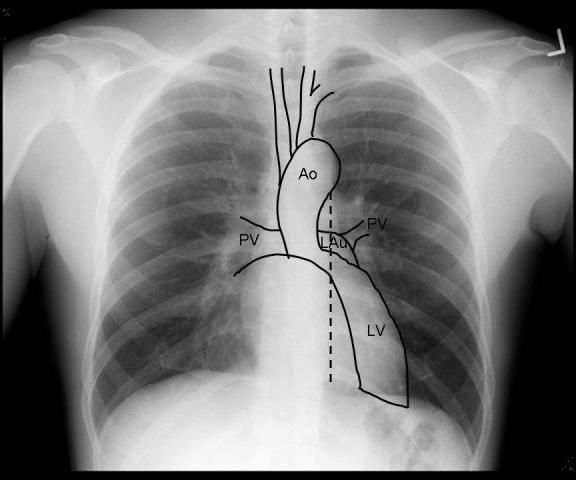
Fig. 3. PA Projections of the Left Heart Structures. Ao is the aortic arch, which then continues as the descending aorta, indicated by the dotted line. LAu is the auricle of the left atrium, which itself sits posteriorly at the base of the heart. PV are the pulmonary veins converging on the left atrium. LV is the left ventricle, which is partially posterior to the right ventricle.
Specific cardiovascular abnormalities on chest radiograph
- Cardiac chamber dilation and hypertrophy
- Left ventricular hypertrophy
- Left atrial enlargement:
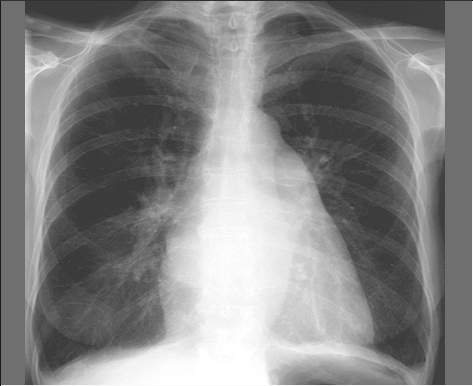
This radiograph of a patient with mitral stenosis shows a prominent left atrial appendage caused by pressure overload of the left atrium.
- Right ventricular/bi-ventricular hypertrophy
- Abnormalities of pulmonary vasculature
- mitral stenosis, pulmonary hypertension
- examples of upper lobe vascular redistribution,
- Cardiogenic Pulmonary Edema
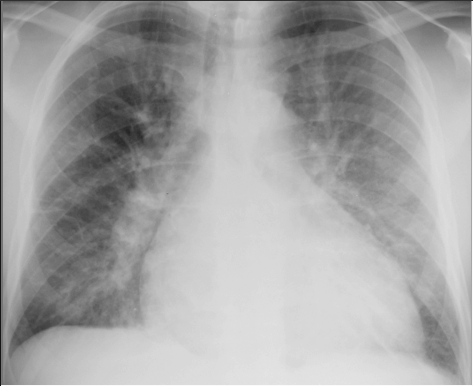
Radiograph of patient with congestive heart failure, showing pulmonary edema with Kerley lines and perihilar engorgement.
- pericardial effusion
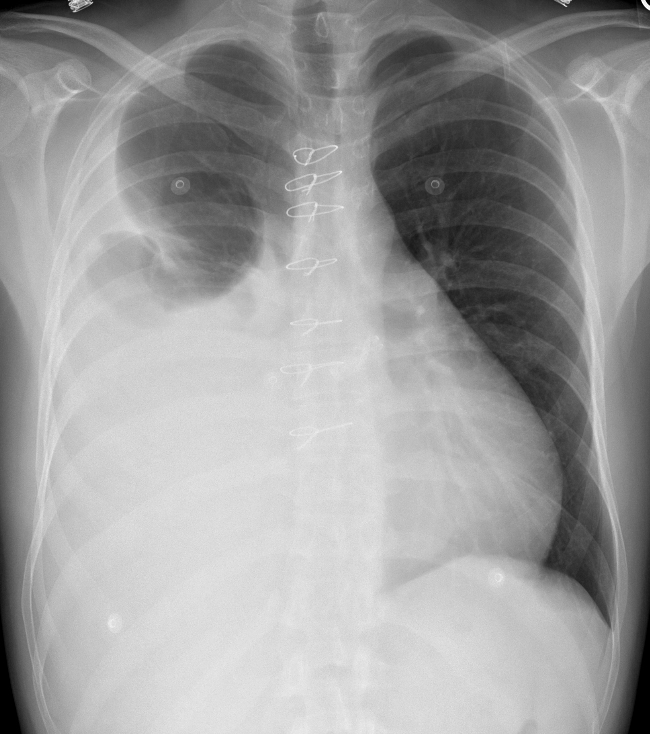
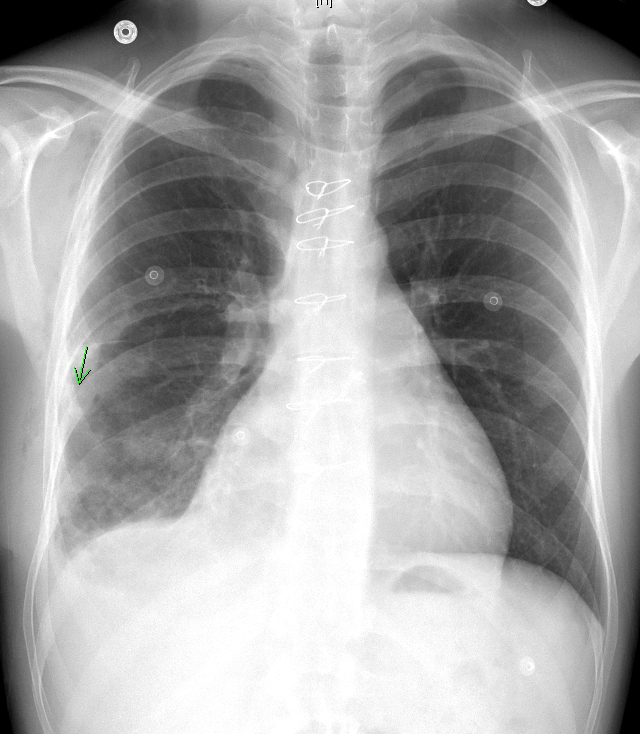
First image, above, shows a patient with an enlarged, globular cardio-mediastinal silhouette representing a large pericardial effusion and a large right-sided pleural effusion one month after aortic valve replacement. The second image is the same patient after pericardiocentesis, which yielded one liter of pericardial fluid, and thoracentesis.
- Tetralogy - patent ductus arteriosus - coarctation of aorta - atrial septal defect - Eisenmenger syndrome
- Situs Inversus
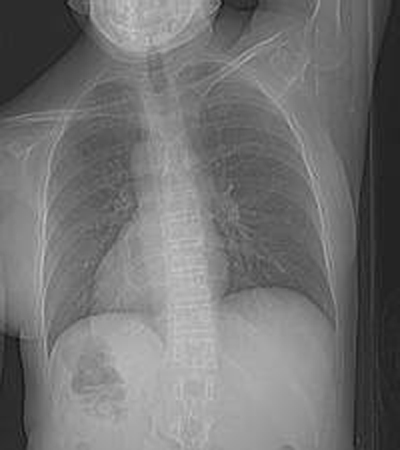
This patient has situs inversus; the viscera including the heart developed in mirror-image fashion relative to their usual positions in the body. This can occur sporadically or as part of Kartagener's syndrome.
Cardiac fluoroscopy
- Cardiac fluoroscopy: Indications and procedural description
Further online resources
- Chest Imaging Tutorial at Michigan State University Department of Radiology
- Case-Based Introduction to Chest X-rays at the University of Liverpool School of Medicine.
- Overview of a systematic approach to reading Chest Radiographs at Everything2.
- Patient information about chest radiography from the American College of Radiology.